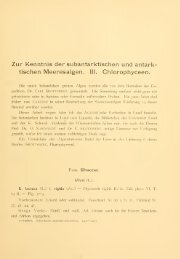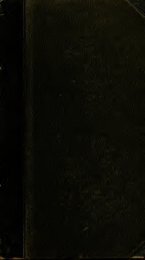Download PDF
Download PDF
Download PDF
You also want an ePaper? Increase the reach of your titles
YUMPU automatically turns print PDFs into web optimized ePapers that Google loves.
SPIROGYRA 125<br />
in thickness, and each cell may have an additional thin pectose<br />
wall and an inner cellulose wall next the protoplast. The trans-<br />
verse or end walls of the cells at maturity are of 4 types: plane,<br />
replicate, semireplicate, and colligate. These are probably funda-<br />
mental cell differences. The first three types have long been used<br />
to separate three primary groups within the genus.<br />
Following cell division the primary wall, or middle lamella of<br />
the partition wall, is composed of a pectic compound and has a<br />
plane surface. The secondary wall of cellulose also is plane in<br />
208 species. In 65 species the cellulose layer develops a circular<br />
cuplike infold. (PI. XXXV, Figs. 5-20.) Two other species have<br />
only a semicircular infold. (PI. XXXV, Figs. 1-4.) In the adja-<br />
cent cell the infold is opposite the plane half so that when these<br />
partition walls are seen from the side, the two folds resemble a<br />
partly open transom.<br />
Not infrequently, in the division just preceding the formation<br />
of gametangia, the walls are plane even in the replicate species.<br />
There is i species (S. colligata) in which the middle lamella con-<br />
tinues to grow in thickness and spread out over the ends of the<br />
cylindric wall. This process results in a collared diaphragm between<br />
successive cells. (PI. XXXI, Figs. 11-13.) Isolated exam-<br />
ples of collared diaphragms may be found in other species.<br />
When cells with plane walls separate, the free ends become<br />
rounded. Free end walls of replicate species have a narrow central<br />
bulge with a distinct shoulder. The free ends of semireplicate<br />
cells have an asymmetric pointed bulge on the half where the<br />
infold occurred. As cells age, the transverse walls may become<br />
thickened and distorted through pectinization.<br />
The replicate walls are curious structures. Since they first were<br />
seen, botanists have exercised their ingenuity to devise some important<br />
use or advantage for them. Frequently they have been<br />
held up as special adaptations for fragmentation. Yet all these<br />
botanists know that plane-walled filaments fragment without dif-<br />
ficulty. When fragmentation occurs throughout a filament, the<br />
protoplasts are on their way to disintegration, not to multiplication.<br />
The nucleus of a vegetative cell is located near its center,<br />
enclosed in cytoplasm supported by cytoplasmic strands, the outer<br />
ends of which usually adjoin a pyrenoid.<br />
The simplest method of propagation and survival over a dormant<br />
period is by akinetes. These may be cylindric thick-walled




